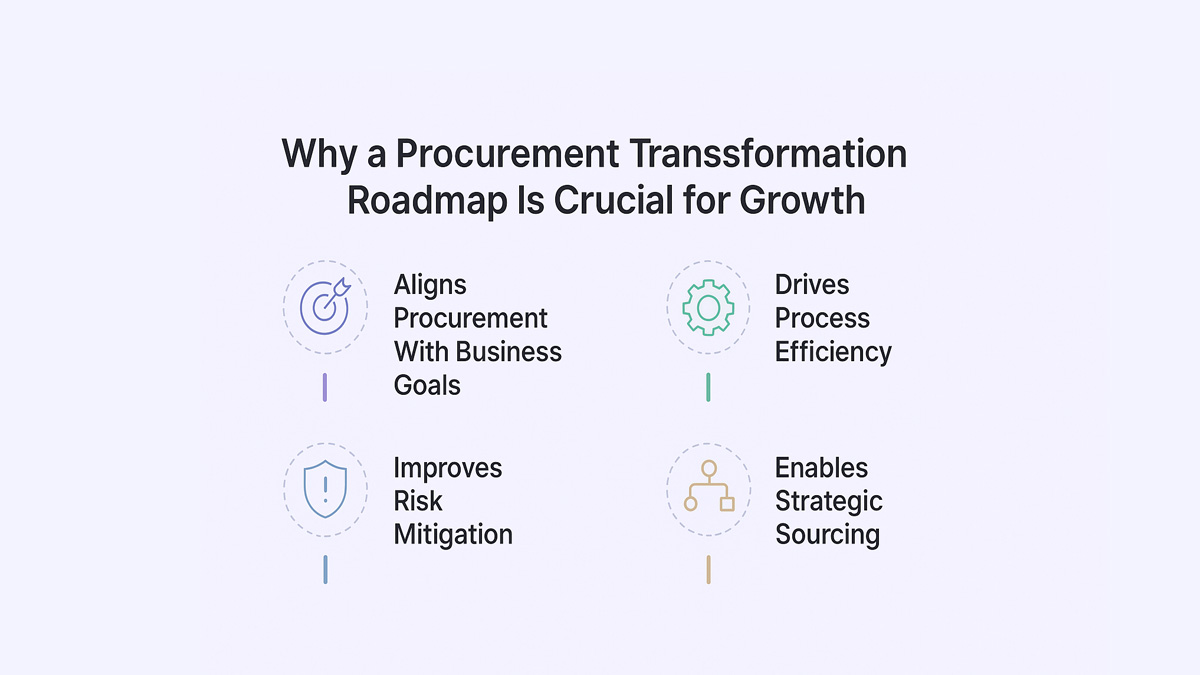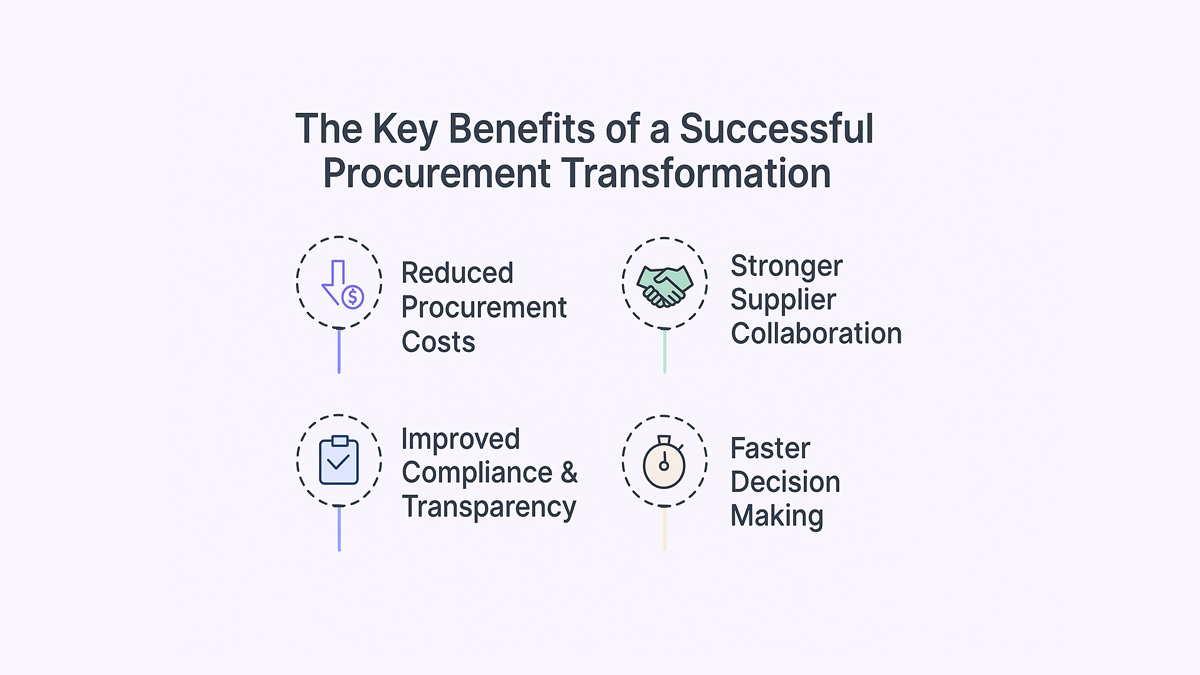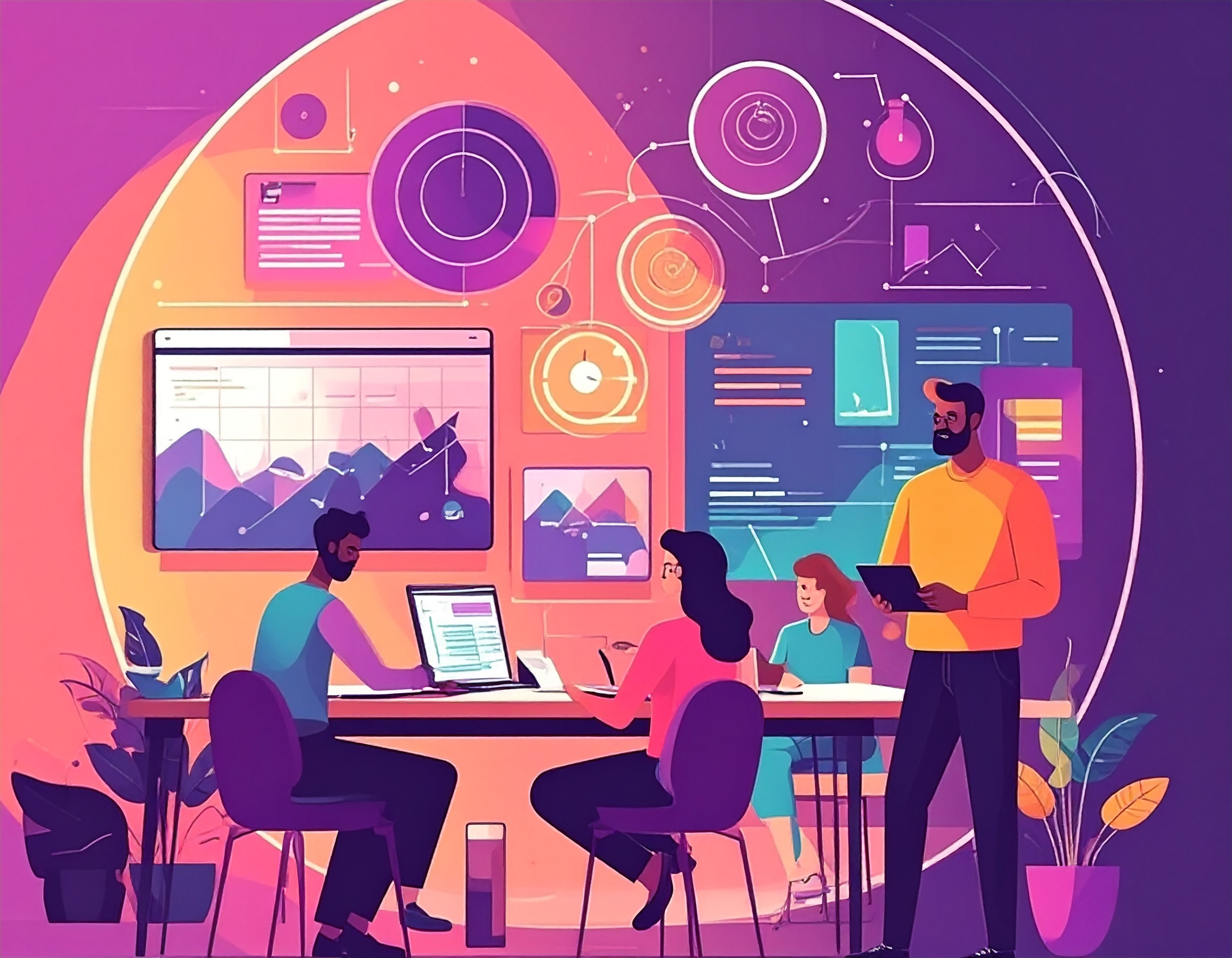

Procurement Transformation Roadmap: Unlocking Productivity with Digitization

Procurement Transformation Roadmap: Unlocking Productivity with Digitization
Learn how to build a procurement transformation roadmap to digitize workflows, reduce costs, and improve procurement performance.


Procurement today isn’t just about buying goods and services. It’s about shaping a function that drives business value, resilience, and innovation. Yet many organizations are stuck with outdated processes and fragmented systems that slow them down. A well-defined procurement transformation roadmap acts like a GPS for change, helping teams move from tactical operations to strategic impact, backed by technology and data-driven decision-making. A successful digital procurement transformation streamlines decision-making and boosts long-term agility.
What this blog covers:
- What is a procurement transformation roadmap?
- Why a procurement transformation roadmap matters
- The 7 stages of procurement transformation
- Key benefits of procurement transformation
- Conducting a procurement transformation assessment
- Critical elements to include in your procurement roadmap
- How Spendflo helps with procurement transformation
- Frequently asked questions on procurement transformation roadmap
What is Procurement Transformation Roadmap?
A procurement transformation roadmap is a structured plan that guides organizations through improving their procurement function. It outlines clear steps to align processes, people, and technology, ensuring procurement evolves from a cost center into a strategic business driver.
Why a Procurement Transformation Roadmap Matters
A procurement transformation roadmap isn’t just a fancy project plan - it’s a strategic lifeline that aligns procurement with broader business goals. Without it, procurement teams risk working in silos, reacting to demands, and missing opportunities for savings and innovation.
Here’s why having a roadmap truly matters:

Aligns Procurement With Business Goals
A transformation roadmap ensures that procurement strategies don’t operate in isolation. Instead, they support the company’s long-term vision - whether it’s cost savings, sustainability, or faster time-to-market. With the roadmap in place, every procurement decision becomes aligned with measurable business outcomes.
Drives Process Efficiency
Manual workflows, disconnected tools, and redundant approvals slow everything down. A transformation roadmap identifies these inefficiencies and replaces them with digital workflows, automation, and leaner operations. The result? Procurement becomes faster, smarter, and far less error-prone.
Improves Risk Mitigation
Global supply chains are more fragile than ever. The roadmap helps companies build in safeguards - from better vendor due diligence to contract lifecycle visibility - so risks are caught and addressed early. Embedding risk management in procurement systems minimizes disruption and strengthens compliance. You gain control, even when external conditions are volatile.
Enables Strategic Sourcing
When procurement has visibility into spend, supplier performance, and market trends, it can shift focus from transactional tasks to value creation. Strategic sourcing becomes easier when you’ve mapped out the tools, skills, and partnerships needed to support it.
The 7 Stages Of Procurement Transformation
Transformation isn’t a single decision. It’s a journey - one that requires structure, clarity, and consistency. These seven stages form the foundation of a successful procurement transformation roadmap.
1. Assess Current State
Start with a candid audit. What tools are in place? How are purchases being made? Where are the bottlenecks? Mapping the current landscape reveals the gaps - and the hidden potential.
2. Define Future Vision
What should procurement look like in 12, 24, or 36 months? Is the goal to automate sourcing, centralize vendor data, or reduce Maverick spend? This vision should be aspirational but grounded in business needs.
3. Build A Roadmap With Milestones
Once the vision is clear, break it down. Define short-term wins, medium-term goals, and long-term transformation objectives. Milestones keep progress measurable and momentum steady.
4. Digitize Core Procurement Processes
From purchase requisitions to approvals and PO generation, manual processes need to go. Introduce digital workflows that streamline operations and reduce time to execution. Process automation in procurement ensures consistency, speed, and fewer errors in procurement operations. Technologies like robotic process automation can further streamline repetitive tasks such as invoice matching and data entry. Adopting digital procurement accelerates cycle times and reduces human error.
5. Establish Change Management Plans
Even the best tools fail without buy-in. Identify change champions, build training programs, and communicate often. Make the case for change not just logical - but emotional and personal.
6. Implement & Integrate Technology
Choose platforms that align with your roadmap goals. Solutions powered by artificial intelligence can provide predictive insights for smarter sourcing. Procurement solutions should integrate easily with finance, ERP, and supplier systems, ensuring seamless information flow across the organization.
7. Track Progress & Iterate
Transformation doesn’t end at go-live. Set KPIs for spend under management, cost savings, and supplier performance. These Key Performance Indicators offer benchmarks to track the ROI of transformation initiatives. Regularly revisit the roadmap to course-correct and optimize based on evolving priorities.
Key Benefits Of Procurement Transformation
Transformation isn’t just about new tools - it’s about unlocking real value. When done right, procurement transformation delivers lasting advantages across cost, speed, compliance, and collaboration. Here’s what you can expect:

Reduced Procurement Costs
Digitized workflows, standardized approvals, and better spend visibility eliminate waste and reduce maverick spending. Procurement teams gain more control over budgets, and cost-saving opportunities become easier to identify and act on. Ongoing spend analysis helps identify patterns and unlock hidden savings opportunities. These improvements contribute directly to sustainable cost reduction.
Stronger Supplier Collaboration
A modernized procurement function enables supplier collaboration with transparent communication, performance tracking, and shared goals. Suppliers become strategic partners - not just transactional vendors - resulting in better service levels, innovation, and long-term value. Strengthening supplier relationships leads to more resilient and responsive supply chains.
Improved Compliance & Transparency
Centralized procurement systems and audit-friendly workflows help teams maintain compliance with internal policies and regulatory standards. Every purchase becomes traceable and auditable - reducing legal risks and boosting accountability. Robust spend management practices further enhance financial governance and visibility.
Faster Decision Making
With real-time data on spend, suppliers, and contract status, procurement leaders no longer have to wait for monthly reports or gut-feel decisions. This marks a shift toward digital transformation in how procurement decisions are made. Procurement transformation gives you the insights you need, when you need them - speeding up everything from sourcing to approvals. These improvements reflect the growing maturity of the procurement industry worldwide.
Conducting a Procurement Transformation Assessment
Before you begin building your roadmap, you need to know where you stand. A procurement transformation assessment offers a clear picture of current maturity, capabilities, and gaps.
Start by evaluating your existing procurement tech stack - are systems outdated, disconnected, or underutilized? Look into your workflows: are processes manual, duplicated, or inconsistently followed? Next, assess team skills and structure - do you have the right talent in place to drive change?
Lastly, benchmark your performance against peers. Using data analytics during this stage reveals trends and gaps that aren’t obvious at first glance. Metrics like purchase cycle time, spend under management, or contract compliance can help quantify how far you’ve come - and how far you need to go.
Critical Elements to Include in Your Procurement Roadmap
Every procurement transformation roadmap needs a solid foundation - not just a list of tasks, but the right building blocks that ensure long-term success. Here are the key elements that belong in every roadmap, regardless of company size or industry:
Digital Tool Integration
Your roadmap must include the adoption and integration of procurement tools that automate sourcing, contract management, and supplier onboarding. Cloud-based solutions offer scalability and faster deployment for procurement functions. Choose tools that fit your processes, not ones that force you to adapt unnecessarily.
Centralized Data Management
Fragmented data kills visibility. Your roadmap should prioritize creating a single source of truth for procurement data - vendor details, pricing, spend categories, and performance metrics - so insights are always accurate and accessible.
Stakeholder Alignment
Procurement doesn’t operate in a vacuum. Finance, legal, IT, and business units all play a role. The roadmap must account for collaboration touchpoints, define ownership, and establish feedback loops to ensure buy-in across departments.
Scalability And Flexibility
The roadmap shouldn’t just solve today’s problems - it should be future-ready. Whether it’s accommodating new geographies, suppliers, or regulations, your plan must remain adaptable. Choose solutions and structures that grow with your business, not against it. Automated procurement systems help organizations scale operations without adding manual workload.
How Spendflo Helps With Procurement Transformation
Spendflo supports your procurement transformation journey from day one. Our platform centralizes your SaaS procurement data, automates manual workflows, and gives you complete visibility into your contract lifecycle. With built-in negotiation support, renewal tracking, and vendor insights, Spendflo helps your team move from reactive to proactive - fast. With machine learning capabilities, teams can forecast spending patterns and vendor needs more accurately. Whether you’re modernizing a chaotic system or scaling a fast-growing business, we help you build a smarter, leaner, and more efficient procurement function.
Frequently Asked Questions on procurement transformation roadmap
What are the key components of a procurement transformation roadmap?
The key components include current state assessment, future-state vision, technology integration, change management, stakeholder alignment, and performance tracking. Each component ensures that transformation is structured, measurable, and aligned with business goals.
How long does a procurement transformation typically take?
Timelines vary based on company size and complexity. A phased transformation may take anywhere from 6 months to 2 years. Quick wins can often be achieved within the first 3 to 6 months by digitizing high-impact processes like contract approvals or vendor management.
Can small businesses benefit from procurement transformation?
Absolutely. While large enterprises may pursue complex overhauls, small businesses benefit by automating manual tasks, gaining better spend visibility, and negotiating smarter. Transformation at a smaller scale often delivers faster ROI and sets a strong foundation for growth.
What are common mistakes to avoid during procurement transformation?
Common pitfalls include underestimating change management, choosing tools that don’t integrate well, skipping stakeholder involvement, and not setting clear KPIs. It’s also critical to avoid over-engineering - start lean, iterate fast, and focus on outcomes.










.png)




.png)










.avif)





